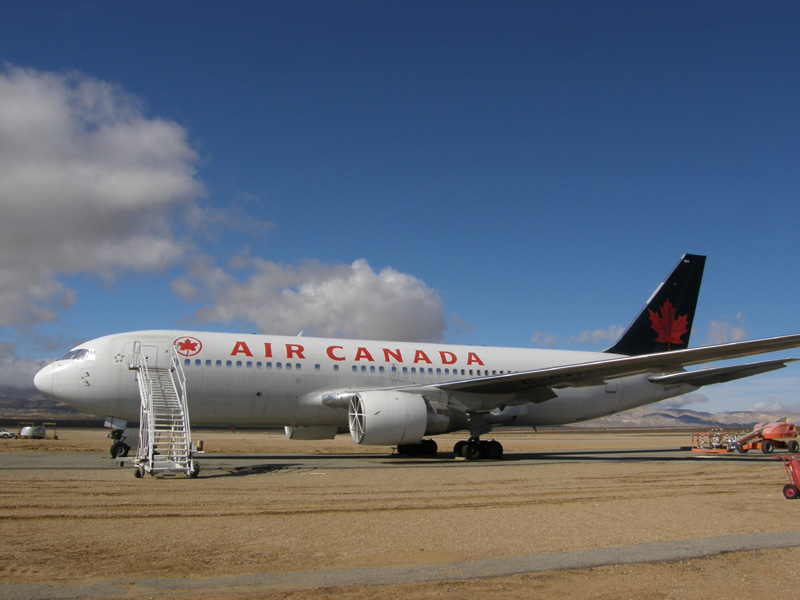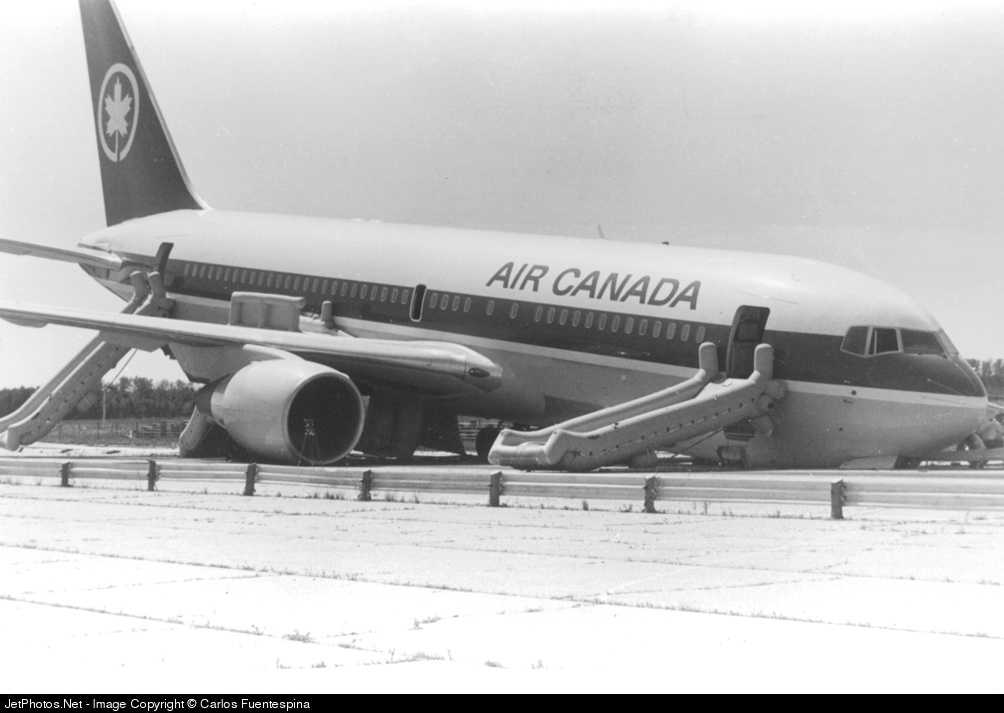In placid skies over central Canada, Air Canada flight 143 is just passed the half way mark of its journey to Montreal to Edmonton. The plane is caring 61 passengers and 8 crew members. It’s July the 23rd, 1983. The captain of this flight is Robert (Bob) Pearson. He is 48 years old and he has spend more than 15000 hours in the air. His first officer is Maurice Quintal who has more than 7000 hours of flying time.
Although the crew have accumulated lot of hours in the air, they have very few in this plane. It’s Boeing’s latest & most advanced wide body jet, the 767. An army of microprocessor in the belly of the plane automates so many functions that the flight engineers job is eliminated. This is one of four 767s that Air Canada has recently acquired. The plane itself has only 150 hours on it.
Suddenly, a warning alerts the crew to critically low pressure at the one of plane’s fuel pumps. The 767 has three main fuel tanks. Two in the wings which are always used and one in the center only used in long distance flights. Electric fuel pumps draw fuel from each tank and feed it to the plane’s two engines. The low pressure warning could mean one of the pumps needs maintenance. But it could also be more serious issue, a lack fuel to be pumped. After sometimes another low fuel pressure warning sounds. This one from another fuel pump on the left side of the plane. Pearson’s flight management computer tells him that he should have plenty of fuel for the remainder of the trip. The 676 also has separate digital fuel gauges. But on this flight, those gauges are out of service.
Captain Pearson knew if the left tank is running low, the right tank may be low as well. Pearson wanted to land as soon as possible in case he is running out of fuel. The crew is still more than 700 miles away from their original destination, Edmonton. The nearest major airport is Winnipeg which is 120 miles away. So Pearson requested and got cleared to land in Winnipeg. So Pearson began to descend from 41000 feet and during the descend another low pressure warning came out. So, Quintal alerts the cabin crew to prepare for an emergency landing.
More and more low pressure warnings came out and finally plane’s left engine flamed out. Losing an engine raises no any doubt, flight 143 is in fact running out of fuel. Pearson is trained to land a 767 with a one engine. No one has ever tried landing with none. So Pearson scrabbled to get his plane down, so he doesn’t become the first. With one engine powering Air Canada flight 143 and with the possibility of the other engine shutting down, the crew prepared the passengers for the worst.
At 26500 feet and 75 miles away from Winnipeg, Pearson lost his second engine and its exactly what Pearson had feared. He lost his both engines. An aeroplane engine not only provide the trust, they also generate power need to manipulate the plane. It would be completely uncontrollable. But modern airliners are like Swiss army knife, one last blade hidden away. In the event of lost of power, they automatically deploy the RAT(Ram Air Turbine) which gives power to basic systems.
Pearson knew that time is running out and he need directions to the closest landing strip. So he requested direction from the control tower. But the lost of the planes engines had an unexpected consequences at air traffic control. Commercial Jetliners are equipped with a transponder, a device that transmit coded information which air traffic controllers used to determine the plane’s location. But when the flight 143 lost its second engine, only a small number of items got backup power. Transponder is not one of them. So the flight disappeared from the radar screen. (Secondary Radar). At that time flight 143 is somewhere east of Winnipeg. But no one knows its exact where and how far it is from Winnipeg.
In spite of its enormous weight, 767 doesn’t plunge from the sky when it looses its engines. It’s aerodynamic property keep it in the air but slowly coasting to the earth. Second officer is trying to figure out how many miles they are moving ahead vs how many thousands of feet they are dropping. But he doesn’t have the instruments which gives him the information he needs to make that calculation. Air Traffic control can’t give that information either as they lost flight 143’s signal. Controllers are hurriedly work to find a way to get the plane’s location using primary radars. Primary Radar is a old fashioned radar which doesn’t need a transponder to locate planes. Finally they found the plane’s location and informed the pilots that they are 65 miles away from Winnipeg and approx. 45 miles away from Gimli. Gimli is a decommissioned Air force base which has only a long runner way, no emergency equipment, no control tower, no any other information.
Pearson must consider the possibility of a crash landing. If he has any chance to making it to Winnipeg, which has the full emergency support, he knew he must try for it. So they continued to Winnipeg. When it is 35 miles away from the Winnipeg, the first officer Quintal informed Pearson that they are not going to make it to Winnipeg as they will hit the ground 15 miles shorter at the runner way. So their only option is Gimli which is 10 miles away.
In order to land, Pearson asked Quintal to lower the landing gear. Because there is no gravity power, Quintal did what know as Gravity Drop, letting the gears own weight drop and lock it into place. The two main gears are heavy and they fall immediately and two green lights confirmed that they are locked. But nose gear is lighter. It didn’t lock. At miles 5 miles to touch down, they learned that they are almost at the runner way but they are much too higher above it. If Pearson come at a normal descent rate, he will miss the landing strip. But if he comes down steeply, his plane will gather a huge amount of speed and Pearson won’t be able to stop the plane before the end of the runner way. They had only two option. One is to do a 360º turn and loose excess altitude and other is to do a manure called Slide Slip. Quintal learned that 360º turn is impossible as they will reach the ground before making the full circle.
Pearson chooses Slide Slip. This is practically unheard on commercial airliners but sometime used by glider pilots. Bob Pearson had lots of experience flying gliders. Slide slipping involves what is know as crossing the controls. Pearson forced the aircraft to a sideways free fall allowing it to drop quickly without increasing its forward air speed. Pearson has never performed a slide slipping in a glider, but he tried his first slide slipping in a Boeing 767. Pearson controls the planes descend by using his rudders and Ailerons to change the angle of the plane. Crossing the controls involves tipping the winds in one direction and turning the aircraft in opposite direction pushing its sideways into the on coming air. Pearson must maintain a crucial balance, he got to slow the plane enough to able to land safely. But if he slows down too much, the airliner could loose its lift and plunge into the ground. When it is 100 of feet from the ground, they learned that the gimli landing strip has been converted into a drag racing strip. As it was a Saturday, it was not only a racing day but also a family day on the gimli strip. Although the racing was down for the day, the airfield is filled with the members of the local sports car club camping out with their families for the weekend.
However Pearson manage to line up the plane with the gimli strip. As soon as the wheels touched down on the runway, Pearson braked hard, skidding and promptly blowing out two of the aircraft’s tires. The unlocked nose wheel collapsed and is forced back into its well, causing the aircraft’s nose to slam into, bounce off, and then scrape along the ground. This additional friction helped to slow the airplane and kept it from careening into the crowds surrounding the runway. After the airliner touched down, the nose began to scrape along the guardrail in the centre of the race track, creating additional frictional drag that helped to decelerate the plane; Pearson applied extra right brake, which caused the main landing gear to straddle the guardrail. At last, Air Canada Flight 143 came to a final stop on the ground 17 minutes after running out of fuel.
Then the crew evacuated the plane. No serious injuries among the 61 passengers or the people on the ground. As the aircraft’s nose has collapsed onto the ground, its tail was elevated and some got minor injuries when they exited the aircraft via the rear slides, which are not long enough to sufficiently accommodate the increased height. A minor fire in the nose area was extinguished by racers and course workers armed with portable fire extinguishers.
Later,the subsequent investigation revealed that a combination of company failures, human errors and confusion over unit measures had led to the aircraft being refueled with insufficient fuel for the planned flight.
After the incident, The aircraft was temporarily repaired at Gimli and flew out two days later to be fully repaired at a maintenance base in Winnipeg. After fully repaired, the flight 143 came into the service carrying the nickname “Gimli Glider“. After almost 25 years of service, flight 143 flew its last revenue flight on January 1, 2008. On January 24, 2008, the Gimli Glider took its final voyage, from Montreal Trudeau to Tucson International Airport before flying to its retirement in the Mojave Desert in California.

In April 2013, the Gimli Glider was offered for sale at auction, by a company called Collectable Cars, with an estimated price of CA$2.75–3 million. However, bidding only reached CA$425,000 and the lot was unsold. According to a website dedicated to saving the aircraft, the Gimli Glider was scrapped in early 2014. Parts of the metal fuselage were made into luggage tags and are offered for sale by a California company, Moto Art.
References:
https://en.wikipedia.org/wiki/Gimli_Glider
https://www.planespotters.net/airframe/Boeing/767/C-GAUN-Air-Canada/reygIkXo
Air Crash Investigation Gimli Glider
Image Courtesy:
https://i.ytimg.com/vi/oKbpR28l9xM/maxresdefault.jpg
https://cdn.jetphotos.com/full/2/81314_1080147332.jpg
https://upload.wikimedia.org/wikipedia/commons/a/a7/Aca-767-C-GAUN-604-080201-01-8.jpg


